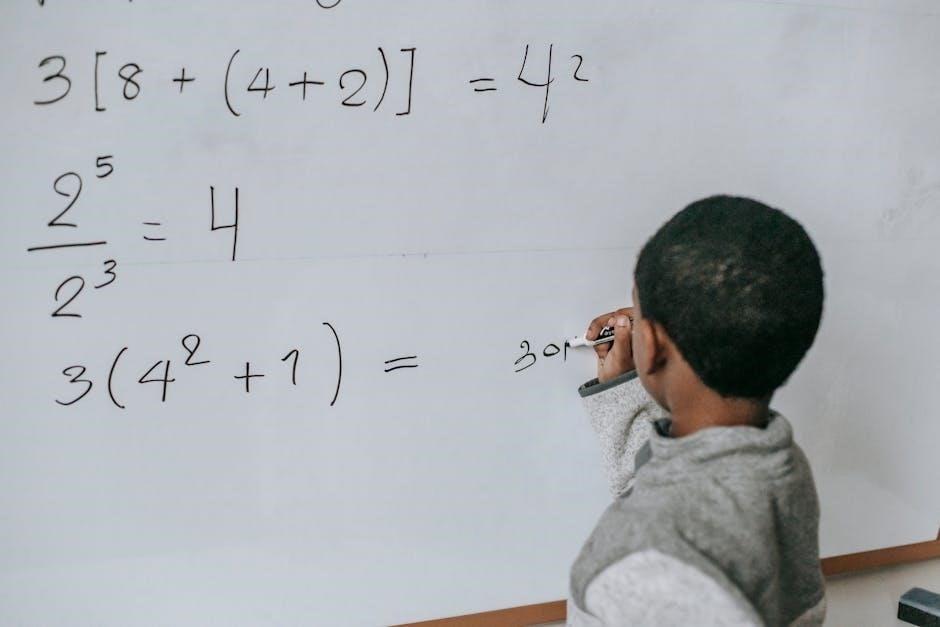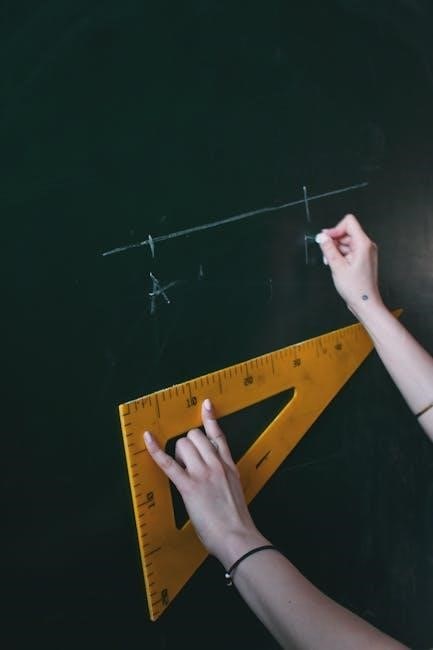Writing equations of lines is a fundamental skill in algebra and geometry, essential for modeling real-world relationships and solving problems․ A worksheet provides structured practice to master this concept․
What Are Equations of Lines?
Equations of lines are mathematical representations that describe the relationship between two variables, typically x and y, defining a straight line on a graph․ These equations provide a way to express the slope and y-intercept of a line, allowing for predictions, modeling, and problem-solving in various fields․ They are fundamental tools in algebra and geometry, enabling the visualization and analysis of linear relationships․ Whether in graphing, calculus, or real-world applications, equations of lines serve as a cornerstone for understanding and interpreting data effectively․ Mastering them is crucial for advancing in mathematics and applying concepts to practical scenarios․

Why Are Equations of Lines Important?
Equations of lines are essential in algebra and geometry, enabling the representation of linear relationships between variables․ They are widely used in real-world applications, such as modeling population growth, financial trends, and scientific data․ Understanding line equations is crucial for solving problems in physics, engineering, and economics․ They also help in graphing and visualizing data, making complex relationships more interpretable․ Mastery of line equations enhances problem-solving skills, allowing individuals to predict outcomes and make informed decisions․ Additionally, they form the foundation for more advanced mathematical concepts, making them a vital tool in both academic and practical contexts․

Understanding the Basics of Linear Equations
Linear equations form the basis of algebra, describing straight lines with constant slopes․ Worksheets provide essential practice in creating and interpreting these fundamental mathematical expressions․
What Is a Linear Equation?
A linear equation is an algebraic expression of degree one, representing a straight line when graphed․ It can be written in various forms, such as standard form (Ax + By = C) or slope-intercept form (y = mx + b), where m is the slope and b is the y-intercept․ Linear equations are fundamental in mathematics, describing relationships between variables that form straight lines․ They are widely used in problem-solving, from basic algebra to real-world applications like budgeting or physics․ Worksheets focusing on linear equations help students master these essential skills, ensuring a strong foundation in algebra and graphing․
The Slope-Intercept Form (y = mx + b)
The slope-intercept form of a line, y = mx + b, is a straightforward equation where m represents the slope and b is the y-intercept․ This form is widely used because it clearly shows how the line behaves: the slope indicates steepness, while the y-intercept identifies where the line crosses the y-axis․ Understanding this form is crucial for graphing lines and analyzing their properties․ Worksheets often include problems that require converting between other forms of equations and slope-intercept form, making it easier to identify key features like slope and intercept․ This form simplifies calculations and interpretations, making it a cornerstone in linear equation analysis․
Identifying Slope and Y-Intercept
Identifying the slope and y-intercept is crucial for understanding and working with linear equations․ The slope, often denoted as ( m ), represents the steepness of the line, calculated as the change in y divided by the change in x (rise over run)․ The y-intercept, denoted as ( b ), is the point where the line crosses the y-axis․ Together, they provide a clear picture of the line’s behavior․ In the equation ( y = mx + b ), ( m ) and ( b ) are easily identifiable, making this form ideal for quick analysis․ Accurately identifying these components ensures correct graphing and interpretation of linear relationships․

Methods for Writing Equations of Lines
There are several methods to write equations of lines, including using two points, point-slope form, slope-intercept form, and standard form, each providing a structured approach․
Using Two Points to Find the Equation
Using two points to find the equation of a line is a common method that involves calculating the slope first․ The slope formula is ( m = rac{y_2 ⸺ y_1}{x_2 ⏤ x_1} ), where ( (x_1, y_1) ) and ( (x_2, y_2) ) are the coordinates of the two points․ Once the slope is determined, you can use the point-slope form ( y ⸺ y_1 = m(x ⏤ x_1) ) or convert it to slope-intercept form ( y = mx + b ) to find the equation․ This method is practical for graphs or real-world data where two points are known․ Always simplify the equation and check for errors in calculations․
Plotting the points on a graph can help visualize the line and confirm the equation’s accuracy․ Regular practice with this method improves understanding of linear relationships and their representations․
Using Point-Slope Form
The point-slope form of a linear equation is a powerful tool for writing the equation of a line when given a slope and a specific point․ The formula is:
- y ⏤ y₁ = m(x ⏤ x₁), where m is the slope and (x₁, y₁) is a point on the line․
- This method is especially useful when you know the slope and at least one point the line passes through․
- By plugging in the known values, you can easily simplify the equation to slope-intercept or standard form if needed․
Mastering point-slope form enhances your ability to write equations of lines efficiently and accurately for various mathematical and real-world applications․
Writing Equations in Slope-Intercept Form
The slope-intercept form of a line is expressed as ( y = mx + b ), where ( m ) represents the slope and ( b ) is the y-intercept․ This form is particularly useful for graphing lines because it directly provides the slope and the point where the line crosses the y-axis․ To write an equation in slope-intercept form, identify the slope ( m ) and use the coordinates of a point on the line to solve for ( b )․ Substitute the known values into the formula and simplify․ This method is efficient when a point and the slope are provided, making it a foundational skill for working with linear equations․
Writing Equations in Standard Form (Ax + By = C)
Standard form, Ax + By = C, is a widely used method to express linear equations․ It is particularly useful for identifying intercepts and comparing coefficients․ To write an equation in standard form, start with the slope-intercept form (y = mx + b) and rearrange it by moving all terms to one side․ Ensure that A, B, and C are integers with no common factors․ This form is beneficial for graphing and solving systems of equations․ Worksheets often include problems that require converting between forms, making it essential to master this skill for clarity and precision in mathematical communication․
Common Errors to Avoid
Common errors include miscalculating slope, misapplying signs, and incorrectly substituting values into equations․ Attention to detail and understanding concepts can help minimize these avoidable mistakes․
Mistakes in Calculating Slope
Mistakes in calculating slope often occur due to incorrect application of the formula or misidentification of rise and run․ For instance, reversing the order of coordinates (y2 ⸺ y1 vs․ y1 ⏤ y2) can lead to errors․ Additionally, forgetting to simplify the fraction or misapplying negative signs is common․ For example, a slope of -2/3 is often miswritten as 2/3 due to sign oversight․ Such errors can significantly affect the accuracy of the equation․ To avoid this, always double-check the calculation and ensure the difference in y-coordinates is divided by the difference in x-coordinates․ Including examples on worksheets can help students identify and correct these mistakes effectively․
Errors in Substituting Values
When writing equations of lines, substituting values incorrectly is a common mistake․ This often occurs when plugging in coordinates or slope-intercept values․ For example, confusing x and y values or misplacing signs can lead to incorrect equations․ Carefully check each substitution to ensure accuracy․ Using incorrect values for slope (m) or y-intercept (b) can also result in errors․ Always verify the values before substituting them into the equation․ Practicing substitution regularly helps build accuracy and reduces mistakes․ Double-checking work is essential to avoid errors in the final equation․
- Mixing up x and y values during substitution․
- Ignoring negative signs or misplacing them․
- Using incorrect slope or y-intercept values․
Forgetting to Simplify the Equation
One common error when writing equations of lines is forgetting to simplify the final equation․ Simplification ensures the equation is in its most basic form, making it easier to interpret and use․ For instance, if you derive an equation like y = 2x + 4 + 3, combining like terms to get y = 2x + 7 is essential․ Neglecting this step can lead to unnecessary complexity and potential errors in graphing or solving problems․ Always double-check your work to ensure the equation is simplified and free of redundant terms․ This practice helps maintain clarity and accuracy in your solutions․

Creating a Worksheet on Writing Equations of Lines
Creating a worksheet on writing equations of lines involves designing a clear layout, incorporating various problem types, and ensuring ample space for calculations and visual aids like graphs․
Designing the Worksheet Layout
Designing the worksheet layout requires careful organization to ensure clarity and readability․ Start by dividing the page into logical sections, such as grids or columns, to separate different types of problems․ Use clear headings and labels to guide students through the exercises․ Incorporate ample white space to avoid clutter and make the content easier to focus on․ Consider adding visual elements like graphs or diagrams to complement the problems․ Ensure instructions are concise and placed at the top or side margins for easy reference․ Finally, include a section for answers or a key at the end for self-assessment․ A well-designed layout enhances the learning experience and keeps students engaged․
Including Various Types of Problems
A well-designed worksheet should include a variety of problem types to cater to different learning needs and skill levels․ This ensures comprehensive understanding and application of concepts․ Problems can range from calculating slope and writing equations in slope-intercept form to converting between standard and point-slope forms․ Including word problems allows students to interpret real-world scenarios, while graphical problems help visualize relationships between points and lines․ Mixing problem types enhances critical thinking and reinforces learning outcomes effectively․

Additionally, incorporating a mix of straightforward and challenging problems helps students build confidence and problem-solving skills․ Diverse problem sets ensure the worksheet is engaging and educational for all learners․
Providing Space for Calculations
Including ample space for calculations in a worksheet is crucial for clarity and organization․ Students often need room to jot down intermediate steps, such as calculating slope or rearranging equations․
A well-designed worksheet should allocate specific areas for these calculations, ensuring that work remains legible and easy to follow․ Additionally, providing lined or grid sections can help students align their work neatly․
This thoughtful design reduces clutter and minimizes errors, allowing learners to focus on the problem-solving process rather than struggling with limited space․ Clear organization also makes it easier for instructors to review and provide feedback․
Adding Visual Aids Like Graphs
Incorporating graphs into a worksheet enhances understanding by providing a visual representation of lines․ Graphs help students interpret equations, identify slopes, and locate y-intercepts․ Including multiple graphs with labeled axes and points allows learners to see how equations correspond to real-world scenarios․ Color-coded lines can differentiate between various types of slopes, such as positive, negative, or zero․ Additionally, graphs enable students to plot points and draw lines based on given equations, reinforcing their comprehension․ Visual aids like graphs make abstract concepts tangible, fostering a deeper connection between algebraic expressions and their geometric interpretations․ This hands-on approach improves problem-solving skills and retention․

How to Solve Problems on the Worksheet
Start by identifying given points or slope, then use point-slope or slope-intercept forms to write the equation․ Calculate carefully and verify your work for accuracy․
Step-by-Step Approach to Writing Equations
Begin by identifying the given information, such as points or slope․ Calculate the slope using the formula ( m = rac{y_2 ⸺ y_1}{x_2 ⸺ x_1} )․ Use the point-slope form ( y ⸺ y_1 = m(x ⸺ x_1) ) or slope-intercept form ( y = mx + b ) based on the data․ Substitute the known values and simplify the equation․ If needed, convert between forms by rearranging terms․ Always check for accuracy by plugging values back into the original problem or graphing the line to verify correctness․ This systematic method ensures clarity and reduces errors in the equation-writing process․
Using Graphs to Identify Points and Slope
To write the equation of a line using a graph, start by identifying two distinct points that the line passes through․ These points should be easy to read from the graph, such as integer coordinates․ Once you have the coordinates of these two points, you can calculate the slope (m) of the line using the formula:
m = (y₂ ⏤ y₁) / (x₂ ⸺ x₁)
After determining the slope, identify the y-intercept (b) by locating where the line crosses the y-axis (where x = 0)․ With the slope and y-intercept known, you can write the equation of the line in slope-intercept form:
y = mx + b
Always double-check your calculations to ensure accuracy․ If the line appears horizontal or vertical, adjust your approach accordingly, as horizontal lines have a slope of 0 and vertical lines cannot be expressed in slope-intercept form․ By carefully selecting points and applying these steps, you can accurately determine the equation of a line from a graph․
Converting Between Different Forms of Equations
Converting between different forms of equations, such as slope-intercept (y = mx + b) and standard form (Ax + By = C), is a critical skill․ To convert from slope-intercept to standard form, rearrange the equation to eliminate fractions and ensure the x and y terms are on one side․ For example, starting with y = 2x + 3, subtract 2x from both sides to get -2x + y = 3, then multiply through by a common factor if needed․ This process helps in understanding the relationship between coefficients and the line’s properties․ Practice with various equations to build proficiency in switching forms seamlessly․
- Start with the slope-intercept form (y = mx + b)․
- Rearrange terms to achieve standard form (Ax + By = C)․
- Ensure coefficients are integers for consistency․
This skill enhances problem-solving flexibility and deepens understanding of linear equations․

Key Concepts to Review
Understanding slope, intercept, and standard form is crucial․ Slope determines steepness, intercept sets the y-axis starting point, and standard form offers alternative representation․ Real-world applications reinforce these concepts․
Understanding Slope and Its Interpretation
Slope represents the steepness of a line, calculated as the change in y over the change in x (rise over run)․ A positive slope rises from left to right, while a negative slope falls․ A zero slope indicates a horizontal line, and an undefined slope signifies a vertical line․ Slope interpretation is vital in real-world applications, such as determining rates of change or modeling linear relationships․ Accurately identifying and calculating slope is foundational for writing equations of lines and analyzing their behavior․ Practicing with various examples enhances understanding and application of slope concepts in different scenarios․
Mastering Slope-Intercept and Standard Forms
Mastering the slope-intercept form (y = mx + b) and standard form (Ax + By = C) is crucial for writing equations of lines effectively․ The slope-intercept form is ideal for identifying the slope and y-intercept directly, making it useful for graphing and understanding the line’s behavior․ In contrast, the standard form is often preferred for its simplicity in representing lines without fractions or decimals․ To master these forms, practice converting between them and apply them to real-world problems․ Worksheets provide structured exercises to strengthen these skills, ensuring accuracy and confidence in handling different equation formats․
Practicing with Real-World Applications
Practicing with real-world applications helps students connect abstract concepts to everyday scenarios․ Worksheets can include problems like calculating distance vs․ time graphs, budget planning, or predicting population growth․ These examples make learning relevant and engaging․ By applying line equations to real-life situations, such as engineering designs or financial trends, students develop problem-solving skills․ This approach fosters a deeper understanding of how linear relationships model the world around us․ Incorporating diverse contexts ensures learners appreciate the versatility of linear equations in various fields, from science to economics․ This practical exposure enhances critical thinking and prepares students for real-world challenges․

Reviewing and Practicing
Regular practice is crucial for mastering the concept of writing equations of lines․ Consistent review helps reinforce understanding, while worksheets provide structured exercises to refine problem-solving skills effectively;
Importance of Regular Practice
Regular practice is essential for building confidence and fluency in writing equations of lines․ Through consistent review, students can reinforce their understanding of key concepts, such as slope and intercepts, and improve their ability to apply these skills to various problems․ Worksheets provide a structured way to practice, helping learners identify and correct common mistakes․ Regular practice also enhances problem-solving speed and accuracy, which are critical for success in mathematics․ By dedicating time to practice, students can master different forms of linear equations and develop a stronger foundation for advanced topics․ Consistent effort leads to long-term retention and improved performance․
Using Worksheets Effectively
Worksheets are invaluable tools for mastering the skill of writing equations of lines․ They provide structured practice, helping students apply concepts to various scenarios․ Start by completing problems systematically, ensuring understanding of each step․ Focus on different types of problems, such as finding equations from two points or converting between forms․ Use the space provided for calculations to keep your work organized․ Reviewing mistakes and seeking feedback are crucial for improvement․ Incorporate visual aids like graphs to enhance comprehension․ Regular practice with worksheets builds confidence and fluency in writing equations of lines, making complex problems more approachable over time․

Seeking Feedback and Correction
Seeking feedback and correction is crucial for improving your skills in writing equations of lines․ After completing a worksheet, review your answers with a teacher or peer to identify mistakes․ Teachers can provide insights into common errors, such as miscalculating slope or misapplying formulas․ Use their feedback to understand where you went wrong and how to avoid similar errors in the future․ Correcting your work helps reinforce learning and builds confidence․ Don’t hesitate to ask questions or clarify doubts—this collaborative process ensures you master the concept effectively․
Mastering the skill of writing equations of lines is crucial for problem-solving in mathematics․ Regular practice with worksheets ensures a strong foundation for advanced concepts and real-world applications․
Mastery of writing line equations involves understanding slope, y-intercept, and various forms like slope-intercept and standard․ Worksheets help reinforce these concepts through structured practice, ensuring accuracy in calculations and problem-solving․ Regular review of key formulas and real-world applications strengthens conceptual understanding․ Avoiding common errors, such as miscalculating slope or forgetting to simplify, enhances proficiency․ By consistently practicing and seeking feedback, learners can confidently apply these skills to various mathematical and practical scenarios, solidifying their foundation in linear equations․
Encouragement for Further Practice
Consistent practice is key to mastering the skill of writing equations of lines․ By dedicating time to worksheets, you’ll build confidence and improve your problem-solving abilities․ Embrace challenges and explore different formats, such as slope-intercept and standard form, to deepen your understanding․ Celebrate small victories and learn from mistakes—they are stepping stones to success․ The more you practice, the more intuitive these concepts will become․ Remember, proficiency in equations of lines opens doors to advanced math and real-world applications; Keep pushing forward, and soon you’ll excel in this foundational skill!